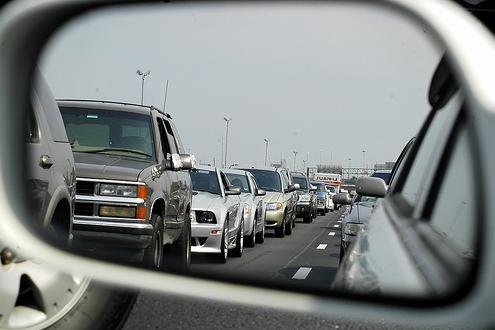DC Most Dangerous Driving City
Aaron Brazell passes along word that DC and Baltimore are the most dangerous driving cities, as calculated by Allstate Insurance. Bengt Havorson has the list:
1. Sioux Falls, SD
2. Fort Collins, CO
3. Chattanooga, TN
4. Cedar Rapids, IA
5. Knoxville, TN
6. Fort Wayne, IN
7. Lexington-Fayette, KY
8. Eugene, OR
9. Boise, ID
10. Colorado Springs, COBottom of the List — Riskiest Driving Cities
1. Washington, D.C.
2. Baltimore, MD
3. Glendale, CA
4. Hartford, CT
5. Newark, NJ
6. Philadelphia, PA
7. Elizabeth, NJ
8. Providence, RI
9. San Francisco, CA
10. Los Angeles, CA
I’ve lived and driven in Chattanooga and now live in the DC suburbs and commute into the city most days. While I found both aggravating, mostly because constant construction projects added to traffic congestion, there’s not much doubt in my mind that DC is a worse place to drive.
Looking at how these are calculated, though, I’m a bit dubious.
To arrive at its lists, Allstate, which has about 11.3 percent of U.S. auto-insurance policies, analyzed its claim data for all collisions resulting in property damage claims. To help reduce the chances of influences like weather or construction, Allstate looked at a period of two years from January 2006 to December 2007. The figures were calculated toward “average years between collision” for drivers, and though they might represent an element of relative risk they’re not being used to determine rates.
Let’s presume that Allstate has representative policy holdings across the states. Wouldn’t “accidents per mile driven” or “accidents per hour driven” by more useful than “years between accidents”?
UPDATE: Steve Bainbridge thinks it may be no coincidence that DC is both the most dangerous city to drive in and that “DC also has more red light and speed cameras than almost any metro area in the country. Indeed, DC has nearly 10% of all the traffic cameras in the United States.”
Meanwhile, Stacy McCain has some, um, interesting suggestions on how to solve the problem.







Mean time between collisions does not seem to account for rate of miles driven over time. I’m a licensed and insured driver but I only drive about 1000 miles a year. Other people might drive 30,000 miles a year. Isn’t it possible that the people in the top ten list simply drive a lot more than the people in the bottom ten? After all Sioux Falls barely even deserves the term “city”. Washington D.C. is 25 times larger in population.
I think we need to look at some safety numbers during the time period in which James Joyner lived in Chatanooga and see if we can draw any conclusions . . .
I suspect that from Allstates perspective time between losses is a fine measure of “safety”. After all, what they are most interested in is claim frequency and cost per claim. In addition, it is unlikely that they have any accurate data about miles or hours driven by their insureds.
If somebody game me a list of these 20 cities and told me that I would have to put them into either of two categories (safe or unsafe driving), I think I would be able to predict most of them based upon (1) density, (2) age of city (the degree of legacy infrastructure issues), and (3) geographic impediments like oceans and mountains. But I think I might have switched Glendale, Cal., and Chattanooga, TN, just because I’m not familiar at all with Glendale and my experience driving the interstate around Chattanooga is that I could imagine a lot of tight, difficult traffic arrangements (plus Georgian border ruffians trying to seize water).
The fact that the list of 10 most dangerous doesn’t include anything in Florida makes me dubious.
Wouldn’t “accidents per mile driven†or “accidents per hour driven†by more useful than “years between accidentsâ€?
Not necessarily. If one has to drive more miles to lead the same life in one town versus another, then you’d want at least somewhat to reflect that fact. That’s no aspersion on the drivers of Los Angeles versus those of Sioux Falls (though the latter are probably a little safer simply from not stewing in traffic for 1/4 of their waking lives). It’s more a reflection of your actual day-to-day, year-to-year risk in one town versus another.
That’s funny. The first time I was in Fort Collins I was walking downtown and there was a pretty big car accident not twenty feet away from where I was standing – the first I’d seen in quite a while and I’d been living in Denver for nearly a year at that point.
Sure Kth, but under your description the safest place in America would be the one with the fewest drivers, which is to say New York City. To only consider the risk posed to drivers skews the analysis in favor of places where driving everywhere is the norm.
Despite the loud headlines whenever there’s a rail or bus accident, driving your own car is still the most dangerous thing the average American does with his time. The safest way to drive your car is to not drive it.
Jeff, actually judging by the list, it would seem that the worst places (like Washington and Newark and Philadelphia) are towns that came of age, so to speak, before WW2 and the widespread adoption of cars. LA (including Glendale, part of the LA CMSA) is the only classic sprawlopolis on the list.
All of the safe places are relatively small towns; based on that pattern, I wouldn’t expect NYC to be among the safest places, even though lots of Manhattanites (less true of outer-borough citizens) don’t drive much or do without cars altogether.
I get your main point: that life lived in LA or Washington compared to that in Cedar Rapids is to some degree apples-to-oranges, as there are far fewer job and leisure opportunities in the latter place. But the time you have to spend in your car (or on a train or bus) has to be factored into both the quality and the costs/risks of your lifestyle.
“Years between accidents” is probably good if you are just wondering what it’s like to live there.